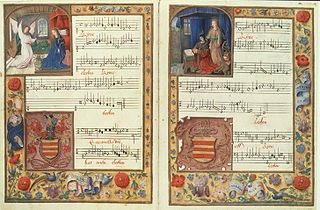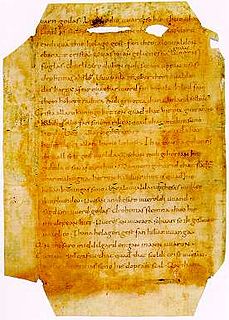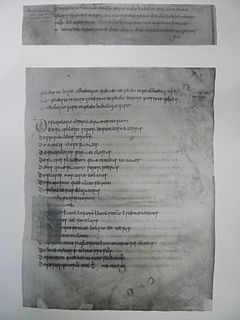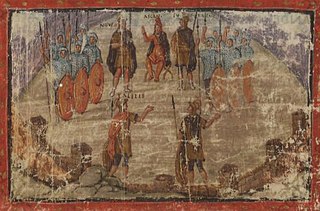 W
WThe Anjou Legendarium is a Gothic illuminated manuscript of a collection of stories from the life of saints important to the House of Anjou of Hungary. It was made on the occasion of the journey of Charles I of Hungary and his son Prince Andrew to Naples in Italy in 1330.
 W
WThe Barberini Gospels is an illuminated Hiberno-Saxon manuscript Gospel Book, assumed to be of a late 8th-century origin.
 W
WThe Chigi codex is a music manuscript originating in Flanders. According to Herbert Kellman, it was created sometime between 1498 and 1503, probably at the behest of Philip I of Castile. It is currently housed in the Vatican Library under the call number Chigiana, C. VIII. 234.
 W
WThe Codex Aureus of Lorsch or Lorsch Gospels is an illuminated Gospel Book written in latin between 778 and 820, roughly coinciding with the period of Charlemagne's rule over the Frankish Empire. Both the manuscript and the carved ivory panels from the cover are rare and important survivals from the art of this period.
 W
WCodex Marchalianus designated by siglum Q is a 6th-century Greek manuscript copy of the Greek version of the Hebrew Bible known as the Septuagint. The text was written on vellum in uncial letters. Palaeographically it has been assigned to the 6th century. Marginal annotations were later added to the copy of the Scripture text, the early ones being of importance for a study of the history of the Septuagint.
 W
WCodex Ríos is an Italian translation and augmentation of a Spanish colonial-era manuscript, Codex Telleriano-Remensis, that is partially attributed to Pedro de los Ríos, a Dominican friar working in Oaxaca and Puebla between 1547 and 1562. The codex itself was likely written and drawn in Italy after 1566.
 W
WThe Codex Vaticanus is one of the oldest copies of the Bible, one of the four great uncial codices. The Codex is named after its place of conservation in the Vatican Library, where it has been kept since at least the 15th century. It is written on 759 leaves of vellum in uncial letters and has been dated palaeographically to the 4th century.
 W
WCodex Vaticanus, designated by S or 028, ε 1027, formerly called Codex Guelpherbytanus, is a Greek manuscript of the four Gospels which can be dated to a specific year instead of an estimated range. The colophon of the codex lists the date as 949. This manuscript is one of the four oldest New Testament manuscripts dated in this manner, and the only dated uncial.
 W
WCodex Vaticanus B, also known as Codex Vaticanus 3773, is an Aztec ritual and divinatory document. It is a member of the Borgia Group of manuscripts. It contains 49 leaves, 48 of them are painted on both sides.
 W
WThe Vatican Terence, or Codex Vaticanus Latinus 3868, is a 9th-century illuminated manuscript of the Latin comedies of Publius Terentius Afer, housed in the Vatican Library. According to art-historical analysis the manuscript was copied from a model of the 3rd century.
 W
WDe Arte Venandi cum Avibus, literally On The Art of Hunting with Birds, is a Latin treatise on ornithology and falconry written in the 1240s by the Holy Roman Emperor Frederick II. One of the surviving manuscripts is dedicated to his son Manfred. Manuscripts of De arte venandi cum avibus exist in a two-book version and in a six-book version.
 W
WThe Divine Comedy Illustrated by Botticelli is a manuscript of the Divine Comedy by Dante, illustrated by 92 full-page pictures by Sandro Botticelli that are considered masterpieces and amongst the best works of the Renaissance painter. The images are mostly not taken beyond silverpoint drawings, many worked over in ink, but four pages are fully coloured. The manuscript eventually disappeared and most of it was rediscovered in the late nineteenth century, having been detected in the collection of the Duke of Hamilton by Gustav Friedrich Waagen, with a few other pages being found in the Vatican Library. Botticelli had earlier produced drawings, now lost, to be turned into engravings for a printed edition, although only the first nineteen of the hundred cantos were illustrated.
 W
WHadith Bayāḍ wa Riyāḍ is a 13th-century Arabic love story. The main characters of the tale: Bayad, a merchant's son and a foreigner from Damascus, Riyad, a well-educated slave girl in the court of an unnamed Hajib of 'Iraq (Mesopotamia), and a "Lady" (al-sayyida).
 W
WThe Heliand is an epic poem in Old Saxon, written in the first half of the 9th century. The title means saviour in Old Saxon, and the poem is a Biblical paraphrase that recounts the life of Jesus in the alliterative verse style of a Germanic epic. Heliand is the largest known work of written Old Saxon.
 W
WThe Indiculus superstitionum et paganiarum is a Latin collection of capitularies identifying and condemning superstitious and pagan beliefs found in the north of Gaul and among the Saxons during the time of their subjugation and conversion by Charlemagne.
 W
WThe Joshua Roll is a Byzantine illuminated manuscript of highly unusual format, probably of the 10th century Macedonian Renaissance, believed to have been created by artists of the imperial workshops in Constantinople, and is now held in the Vatican Library.
 W
WThe Libri Carolini, Opus Caroli regis contra synodum, also called Charlemagne's Books or simply the Carolines, are the work in four books composed on the command of Charlemagne, in the mid 790s, to refute the conclusions of the Byzantine Second Council of Nicaea (787), particularly as regards its acts and decrees in the matter of sacred images. They are "much the fullest statement of the Western attitude to representational art that has been left to us by the Middle Ages". Two earlier Frankish tracts against images had been sent in 792 to Pope Hadrian I, who had replied with an attempt at a refutation. The Libri Carolini was then composed as a fuller rebuttal of Hadrian's position. But Charlemagne realized that further controversy with Rome would serve no purpose, and the work was never sent. It remained unknown until it was published in 1547, in the very different context of the debates over images at the Reformation. The work in no way recommends the destruction of images but deplores a cult of images; it thereby anticipated the Lutheran rather than the Calvinist attitude to religious art. Despite this John Calvin refers to it approvingly in later editions of his Institutes of the Christian Religion, and uses it in his argument against the veneration of images.
 W
WThe Lorsch Bee Blessing is a bee-keeping prayer intended to bring home honey bees in good health to their hives. It is believed to have been written in the 9th century, and was discovered in a manuscript from the monastery in Lorsch, Germany, famous for the Lorsch Codex. Despite being a Christian prayer written in Old High German, it has remarkable similarities to the Anglo-Saxon and apparently pagan "For a Swarm of Bees" magic charm, and may reflect a common pre-Christian Germanic cultural heritage.
 W
WThe Menologion of Basil II is an illuminated manuscript designed as a church calendar or Eastern Orthodox Church service book (menologion) that was compiled c. 1000 AD, for the Byzantine Emperor Basil II. It contains a synaxarion, a short collection of saints' lives, compiled at Constantinople for liturgical use, and around 430 miniature paintings by eight different artists. It was unusual for a menologion from that era to be so richly painted. It currently resides in the Vatican Library . A full facsimile was produced in 1907.
 W
WMinuscule 157, ε 207 (Soden), is a Greek minuscule manuscript of the New Testament Gospels, on vellum. According to the colophon it is dated to the year 1122. Formerly date was wrongly deciphered as 1128?. It has complex contents and full marginalia.
 W
WMinuscule 165, ε 1320 (Soden), is a Greek-Latin minuscule manuscript of the New Testament, on parchment. It is dated by its colophon to the year 1292. It has complex contents. It has marginalia.
 W
WMinuscule 863, Θε301, is a 12th-century Greek minuscule manuscript of the New Testament on parchment. The manuscript has no complex context.
 W
WMinuscule 865 (in the Gregory-Aland numbering), A502 (von Soden), is a 15th-century Greek minuscule manuscript of the New Testament on paper. The manuscript has complex context, no marginalia.
 W
WPapyrus 72 is the designation used by textual critics of the New Testament to describe portions of the so-called Bodmer Miscellaneous codex, namely the letters of Jude, 1 Peter, and 2 Peter. These books seem to have been copied by the same scribe, and the handwriting has been paleographically assigned to the 3rd or 4th century. Although the letters of Jude and 1-2 Peter in this codex do not form a single continuous text, scholars still tend to refer to these three texts as a single early New Testament papyrus.
 W
WPapyrus 75 is an early Greek New Testament papyrus. It is generally described as "the most significant" papyrus of the New Testament to be discovered so far. This evaluation of the manuscript is a result of the early date that has usually been assigned to it and the fact that its text so closely resembles that of the fourth-century Codex Vaticanus. However, the early date of 75, and therefore its importance for the textual criticism of the New Testament, was called into question in 2016.
 W
WThe Vatican Croatian Prayer Book is the oldest Croatian vernacular prayer book and the finest example of early Shtokavian vernacular literary idiom.
 W
WThe Vergilius Romanus, also known as the Roman Vergil, is a 5th-century illustrated manuscript of the works of Virgil. It contains the Aeneid, the Georgics, and some of the Eclogues. It is one of the oldest and most important Vergilian manuscripts. It is 332 by 323 mm with 309 vellum folios. It was written in rustic capitals with 18 lines per page.
 W
WThe Vergilius Vaticanus, also known as Vatican Virgil, is a Late Antique illuminated manuscript containing fragments of Virgil's Aeneid and Georgics. It was made in Rome in around 400 C.E., and is one of the oldest surviving sources for the text of the Aeneid. It is the oldest and one of only three ancient illustrated manuscripts of classical literature.